Complete Guide to Sailboard Equipment for Enthusiasts
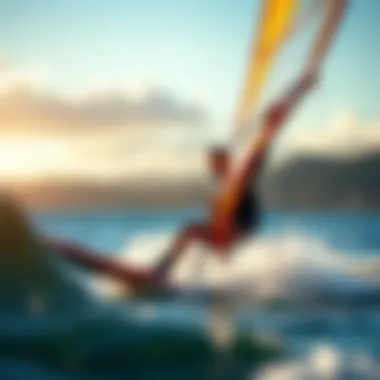
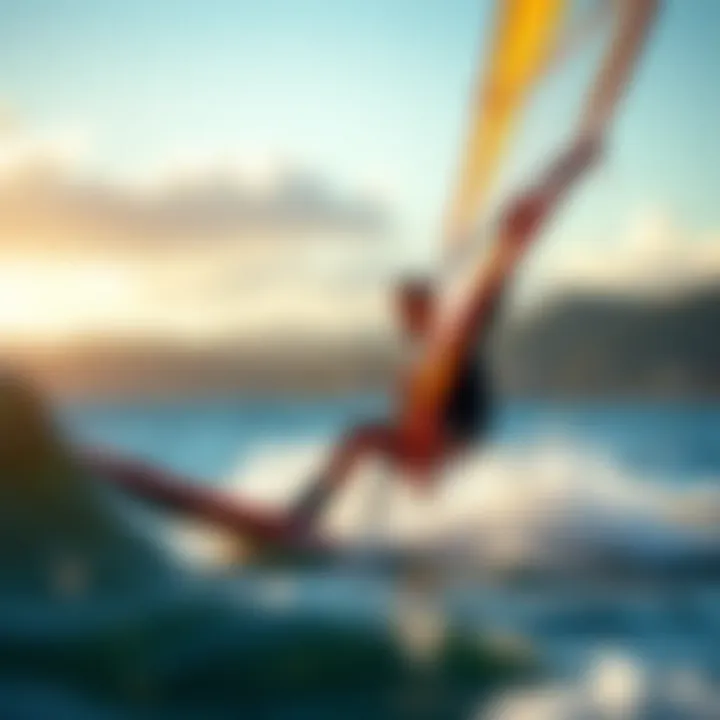
Intro
Engaging in sailboarding is an adventure that combines agility, technique, and the thrill of nature’s forces. As any seasoned practitioner will tell you, the right gear is paramount for optimizing your performance and enjoyment on the water. This overview aims to guide both novices and experts through the diverse landscape of sailboard equipment, emphasizing how the right choices can elevate experiences. Dive in, and discover the intricate interplay of technology and technique that defines this exciting sport.
Gear and Equipment
The world of sailboarding is as vast as the ocean itself, with an array of equipment designed to cater to different skill levels and conditions. Selecting the appropriate gear can sometimes feel overwhelming, but understanding the fundamental components can simplify the process.
Latest Sailboard Technologies
Modern sailboarding has seen an impressive evolution in technology. Boards are now frequently made from materials such as carbon fiber and epoxy resin, leading to lighter and stronger constructions. The latest models boast features such as:
- Hydrodynamic Shapes: Enhanced designs that reduce drag and improve glide performance.
- Modular Systems: Some boards allow for customization, letting users adjust the size or shape to suit various water conditions or personal preference.
- Integrated Digital Technology: A growing trend, some boards now come with built-in sensors to track speed, distance, and other metrics, making it easier for surfers to analyze their performance.
These advancements have opened doors for both new and seasoned sailors, enhancing both capabilities and enjoyment on the water.
Essential Accessories for Every Surfer
While the sailboard itself is crucial, don’t forget about the accessories that complete the sailing experience. Here are some essentials:
- Life Vest: Safety is non-negotiable. A well-fitted life vest is not just advisable but often mandatory.
- Foot Straps: These allow you to remain firmly connected to the board during maneuvers, providing more control.
- Wetsuit: Temperature can significantly impact performance; a suitable wetsuit keeps you warm and agile.
- Pump: Keeping the sail inflated at the right pressure is critical for optimal performance.
- Repair Kit: Accidents happen. Having a repair kit on hand can save your day on the water.
Equipping oneself with these accessories not only enhances safety but also maximizes the potential for performance improvement.
"The right gear can mean the difference between a great day on the water and a frustrating one."
Surf Techniques and Skills
Having the right equipment is just one piece of the puzzle. Mastery of techniques is another, requiring time and practice to refine. For those willing to dedicate themselves, the rewards are substantial.
Beginner Surfing Techniques
New surfers should focus on mastering foundational skills before progressing to advanced maneuvers. Important beginner techniques include:
- Balancing on the board: Start on flat water to get a feel for the board and build confidence.
- Basic sail handling: Learn how to pull and trim the sail for optimal speed and direction control.
- Tacking and gybing: Essential maneuvers to change direction effectively and keep moving even when the wind shifts.
These basic steps provide a solid foundation for further skill development.
Advanced Maneuvers for Experienced Surfers
Experienced surfers often seek thrills that come from ambitious maneuvers. Some of these include:
- Jumping and aerial tricks: Requires precise timing and synchronization between sail and board, pushing both equipment and skills to the limit.
- Carving turns: Utilizing edges effectively allows surfers to navigate waves more adeptly, enhancing speed and maneuverability.
- Windward and leeward sailing: Understanding these principles enables surfers to sail effectively in various wind conditions.
These advanced techniques can greatly enhance your sailing repertoire, allowing for more dynamic experiences on the water.
With the right gear, accessories, and skills, you’re well on your way to enjoying the exhilarating world of sailboarding. As you delve deeper into this guide, consider not just how to ride the waves, but how to live the experience fully.
Prolusion to Sailboarding
Sailboarding, a thrilling combination of surfing and sailing, has captivated the hearts of many outdoor enthusiasts. This sport not only allows you to harness the wind but also offers a unique way to connect with nature and the elements. Understanding sailboarding is more than just learning how to maneuver the board and sail; it's about embracing an exhilarating lifestyle that promotes freedom, adventure, and exploration of picturesque waterways.
As one delves into the world of sailboarding, several key elements come into play. First and foremost, familiarity with the equipment is essential. Knowing your sail, board, mast, and boom can make or break your experience on the water. Beyond just the components, understanding the interplay between them forms a solid foundation for any sailboarder.
In addition, consider the benefits of learning this sport. The core physical demands of sailboarding can improve overall fitness while sharpening your balance and coordination. Moreover, sailboarding offers mental wellness by encouraging mindfulness, as the rush of wind and the sound of water beneath your board can render daily worries at bay—at least for a while.
As we step into our discussion about the basics and historical context of sailboarding, keep in mind that this sport is rooted in rich traditions. The evolution of sailboards through time reflects not only advancements in technology but also shifts in cultural perceptions of water sports. Understanding this background paves a way to greater appreciation of sailboarding and its community.
"To sail is to embrace the unknown, to dance with the winds, and to forge your own path through the waves."
Ultimately, grasping the significance of this sport and its components will not only enhance your sailboarding experience but will also deepen your connection with fellow enthusiasts. In the next sections, we will unpack these fundamentals in greater detail, exploring the basics of sailboarding and taking a journey through its historical landscape.
Essential Sailboard Components
Understanding the essential components of a sailboard is crucial for both novice and experienced enthusiasts alike. Each component plays an integral role in determining the performance of the sailboard, which in turn affects the overall experience of the sport. A well-chosen combination of sails, boards, masts, and booms contributes to better handling, enjoyment, and safety while sailing. In this section, we delve deeply into the various essential components, breaking them down into several categories to ensure comprehensive coverage of their features, benefits, and considerations.
The Sail
Types of sails
When discussing types of sails, it's important to note that they are not merely sheets of fabric; they are the driving force behind movement. Sails can be broadly categorized into several types, each designed for specific conditions and riding styles. For instance, there's the cambered sail, ideal for stability and power in high winds. Conversely, soft sails are often preferred by beginners because they enable a gentler learning curve. Each type has its unique characteristics that cater to different sailing preferences.
The choice of sail type is not just about preference; it directly influences the efficiency of navigating the waters. For example, closed-celled sails have a tendency to hold their shape better in varying wind conditions, thus providing a consistent performance. However, they might feel heavier and cumbersome to handle, which could be a disadvantage for those who prioritize maneuverability.
Sail materials
The materials used in sail manufacturing are another vital consideration. Traditionally, sails were made from cotton or Dacron, but advancements in technology have introduced mylar and tri-laminates. These contemporary materials provide enhanced durability and reduced weight, making them wildly popular among competitive sailors.


A standout feature of modern sail materials is their ability to maintain structural integrity while significantly decreasing drag. However, while these high-tech materials can elevate performance, they also come with a heftier price tag, which could be a deterrent for the casual sailor.
Sail sizes and their impact
Sail size is another critical aspect that can’t be overlooked. The size of the sail affects the control and stability of the board. A larger sail offers increased surface area for wind capture, translating to more speed, but can be an outright challenge for beginners to manage effectively. On the flip side, smaller sails are easier to handle but don’t harness as much wind potential.
Ultimately, the impact of sail size is about finding a balance which can vary based on individual skill levels and environmental conditions. Learning to pick the right size is an education in itself; it’s like finding the perfect pair of shoes – if they don’t fit well, they're not going to give you the performance you seek.
The Board
Shape and design considerations
When it comes to the board, shape and design are paramount. A board’s outline can significantly influence aerodynamics; for instance, boards with a narrower width generally allow for faster speeds, while wider boards provide greater stability. The rocker or the curve of the board also plays a pivotal role; a pronounced rocker is beneficial for maneuverability, especially in choppy waters.
Choosing the right shape involves understanding your sailing style, as some designs excel in high-speed conditions while others flourish in more casual settings. This attention to detail is often what separates thrill-seekers from leisurely adventurers.
Material choices
The choice of materials in board construction cannot be overlooked, either. Boards are commonly made from foam, fiberglass, or more advanced materials like carbon fiber. Each material comes with its own traits; for example, carbon fiber boards are lightweight and sturdy but tend to cost a pretty penny.
Moreover, boards made from varied densities offer flexibility in performance. Keeping a keen eye on material choice can enhance longevity and adaptability across various water conditions.
Board dimensions and stability
Dimensions such as length and width are vital to stability. A longer board typically provides better tracking and straight-line speed, making it perfect for racing. Conversely, a shorter board tends to be more agile, excellent for sharp turns and tricks. Stability in a board directly correlates with its width; wider boards are easier to balance on. Knowing the right dimensions to choose is like picking a pizza size; what you find satisfying varies from person to person.
Mast and Boom
Mast types and their roles
Masts serve as the backbone of the sail structure, and they come in multiple types like fixed and telescoping. Fixed masts are known for their strength and durability, making them favored for high-performance sailing. On the other hand, telescoping masts offer the benefit of portability and are easier to transport, catering especially to those who may travel for their sailboarding adventures.
The choice of mast ultimately hinges on one’s priorities—whether it is performance or convenience. Given the versatility of masts, they can significantly alter how the sailboard interacts with the wind.
Boom adjustments
The boom, connecting the sail and the sailboard, is incredibly important for maintaining control. Being able to adjust the boom allows for tailored handling characteristics to suit the wind's dynamics. A well-adjusted boom not only enhances the performance but also makes navigating extreme wind conditions less daunting.
Fine-tuning the boom to the desired height can drastically impact how a sailor engages with the wind, creating a more comfortable experience throughout a day spent on the water.
Material benefits
Like masts, booms come in a variety of materials. Typically, they are made from aluminum or carbon fiber. Aluminum booms offer a good balance of strength and weight but may be prone to bending. On the flip side, carbon fiber booms are robust yet surprisingly light, allowing for quick adjustments and easier handling.
Weighing the pros and cons of materials is key, as this choice can make or break a sailing session. Knowing what works best for your conditions and style could be the difference between an exhilarating ride and a frustrating experience.
Advanced Technology in Sailboard Equipment
The realm of sailboarding has evolved significantly over the years, and the introduction of advanced technology has played a crucial role in this transformation. As enthusiasts dive deeper into the sport, understanding these technological advancements becomes imperative not only for enhancing performance but also for ensuring safety and enjoyment on the water. In this section, we'll delve into innovations in materials and navigational aids that are redefining the sailboarding experience.
Innovations in Materials
Carbon fiber advancements
Carbon fiber is arguably one of sailboarding's finest innovations. This lightweight yet incredibly strong material contributes to both the performance and durability of equipment. One of the reasons that carbon fiber has become a top choice among manufacturers is its ability to enhance responsiveness without adding unnecessary weight. For example, a carbon fiber mast can significantly improve the sail's ability to maintain tension, creating a more efficient sailing experience.
The unique feature of carbon fiber is its high stiffness-to-weight ratio. Consequently, sailors often notice enhanced control during sprints and turns, making it an attractive option for those who prioritize speed. However, it's critical to handle this material with care; while it’s strong, it can be susceptible to impact damage if mishandled.
Composite materials
Composite materials represent another crucial aspect of modern sailboard construction. By combining different substances, manufacturers have created boards and sails that leverage the benefits of each material used. Generally, fiberglass and carbon fiber composites are popular choices, striking a balance between weight, strength, and flexibility.
A key characteristic of composite materials is their versatility. This variability allows for customization, catering to various sailing styles and conditions. Sailboards made from composites can withstand the rigors of the ocean while ensuring that sailors experience stability and control. However, it’s worth noting that this adaptability sometimes comes at a higher price point, which could be a consideration for budget-conscious enthusiasts.
Environmental considerations
In an era where sustainability is becoming increasingly significant, environmental considerations in sailboard equipment cannot be ignored. Many companies are searching for eco-friendly materials that minimize the environmental footprint while maintaining high performance levels. Biodegradable resins and recyclable composites are gaining traction, allowing enthusiasts to enjoy their passion while being conscientious about nature.
The main advantage of prioritizing environmentally friendly materials is the reduced impact on waterways and marine ecosystems. Sailboarders who emphaize sustainability not only contribute positively to their sport but also appeal to a growing market that values green practices. That said, the development of such materials is still in its infancy, and they may lag behind traditional options in terms of performance benchmarks.
Navigational Aids
GPS for sailboarding
GPS technology has made waves in the sailboarding world, offering real-time navigation data that enhances the experience. It allows sailors to track their routes, speed, and even wind patterns, which can improve decisions while out on the water.
A key characteristic of GPS devices is their precision in mapping and tracking. Sailors, especially those venturing into unfamiliar waters, greatly benefit from having a reliable navigational aid. However, it’s worth mentioning that reliance on GPS can sometimes lead to disconnecting from instinctual sailing skills, which is an art that cannot be fully replaced by technology.
Wind and weather monitoring tools
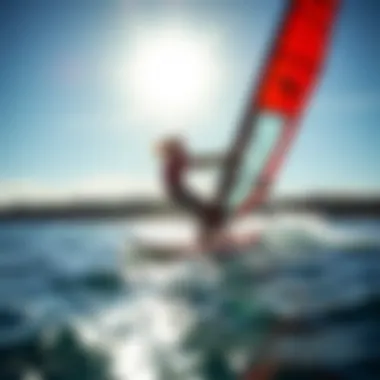
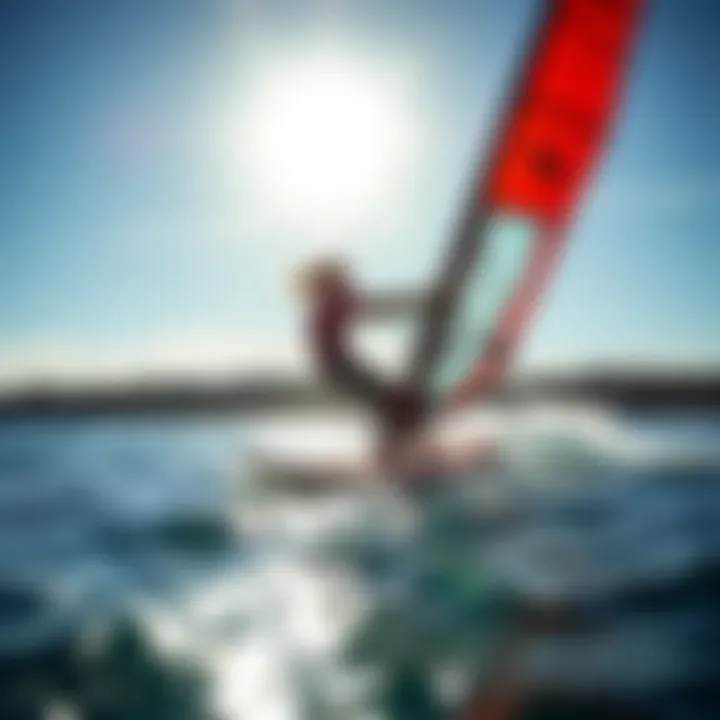
Wind and weather conditions are paramount for successful sailboarding, and tools that monitor these factors are becoming more sophisticated. Devices that measure wind speed, direction, and weather patterns can be game-changers for sailors looking to optimize their sessions.
The primary advantage here is the ability to plan outings based on real-time data. Knowing when conditions will be favorable—or not—ensures safety and improves overall experiences. However, sailors must also consider that technology is not infallible; fluctuations in weather can occur quickly and unexpectedly.
Smartphone apps integration
The integration of technology via smartphone apps has ushered in a new age for sailboarding enthusiasts. There are numerous applications that help track performance, monitor conditions, and even connect with local communities. Apps like Windy or SailFlow help sailors make educated decisions about when to hit the water or where to find the best spots.
These apps stand out for their user-friendly interfaces and community features that promote sharing experiences and tips. Still, one must be cautious; over-reliance on technology can detract from the joy of simply being out on the water, where sometimes the best judge is nature itself.
"The latest advancements in sailboard technology not only enhance performance but also enrich the overall experience by making strategic sailing a reality."
Choosing the Right Equipment
Choosing the right equipment is like selecting the perfect ingredients for a fine dish; each piece has its role to play. It’s crucial for enhancing your experience on the water. Sailboarding isn't just about the thrill of catching waves; it’s about finding a balance between your skill level, the environmental conditions, and personal preferences. When you have the right gear, you become more attuned to the flow of wind and water, making the whole experience so much more rewarding.
Consideration for Skill Level
Beginners' essentials
When stepping into the world of sailboarding, starting off with the right gear is vital. For beginners, the essence lies in simplicity and ease of use. They often require boards that offer stability, hence why many opt for wide, thick boards that help keep them afloat and steady.
The Advantage: These boards allow newbies to spend more time learning the ropes rather than worrying about falling in too often. A beginner board usually has softer edges and a larger surface area, making it forgiving on mistakes.
Unique Feature: The simplicity of the rigging also plays a part. Easy setup sails can help prevent frustration during your first outings. This beginner-friendly approach is essential for nurturing a love of the sport right from the get-go.
Intermediate gear choices
As skills improve, so do preferences and needs. Intermediate surfers often look for boards that provide a bit more agility. These might be more narrow, allowing for sharper turns and speed. Choosing an intermediate board can transform your experience by pushing the boundaries of what you can do.
The Advantage: They allow more room for personal flair and different techniques. With moderate adaptability, the next level of sailboards starts accommodating performance while still being forgiving enough for a learner.
Unique Feature: Many intermediate boards also come with adjustable fins, offering various set-ups depending on the wave conditions or personal technique; this versatility is quite the game changer.
Advanced equipment specifications
For those seasoned in the sport, equipment choices get a bit more specialized. Advanced sailors often seek out high-performance boards designed for speed and responsiveness. Materials can shift to lightweight constructions like carbon fiber, offering a distinct advantage in handling and performance.
The Advantage: High-end mast and sail combinations enable faster speeds and smoother transitions. At this level, equipment affects precision; an advanced board might cater closely to competitive styles or personal tactics on the water.
Unique Feature: Specialized sails that are more narrow and have reinforced stitching provide better wind management, ensuring sailors can truly harness the elements to their advantage.
Environmental Factors
Wind conditions
The wind is the heartbeat of sailboarding; it drives everything. Understanding how to read wind patterns is essential in selecting the right gear. Light winds may demand a larger sail that captures what little breeze there is, while stiff winds call for a smaller sail to maintain control.
The Advantage: Adapting gear to wind conditions means you can enjoy the sport regardless of the weather. A skilled sailor aligns board size and sail type based on these conditions, maximizing their time on the water.
Water conditions
Beyond just the wind, the nature of water plays a large role in gear selection. Calm waters often favor boards that prioritize stability, while choppy, aggressive waves might lend themselves to more performance-oriented options.
The Advantage: Matching your gear with water conditions can lead to a more enjoyable experience. Understanding whether to go with a shorter or longer board can significantly change your ride and overall control.
Personal preferences
Ultimately, personal preferences become the cherry on top of choosing equipment. Everyone's experience and style is different, leading to varied choices in equipment. Some might favor a larger sail for easier handling, while others may prefer a high-performance setup for speed and agility.
The Advantage: Equipment that feels right can encourage a more profound connection to the sport, enhancing enjoyment and proficiency.
By considering skill level, environmental factors, and individual preferences when choosing equipment, a sailor is setting themselves up not just for competency, but also for enjoyment and satisfaction on the water.
Maintenance of Sailboard Equipment
Maintaining sailboard equipment is not just a chore; it is a crucial part of ensuring longevity and performance in the sport. Each component of the gear requires specific attention, as neglect can lead to diminished performance and even accidents. The unique nature of sailboard equipment means that frequent usage in variable conditions makes regular maintenance a non-negotiable aspect for both safety and enjoyment. Regular checks also help in identifying potential issues early, which can save time and money in the long run.
Routine Care and Checks
Routine maintenance involves understanding the equipment's requirements and adopting practices that enhance its lifespan.
Sail maintenance techniques
The sails are arguably the most critical component of the setup. A proper sail maintenance routine focuses on cleaning and inspecting the fabric as well as rigging periodically. This technique emphasizes the importance of removing salt and debris after each use, as these can lead to wear and tear. Moreover, being attentive to patching any tears immediately is essential since a compromised sail can drastically affect performance.
Checking the stitching and looking for signs of UV damage are beneficial practices that can save a sailor from mid-session surprises. If a sailor neglects these aspects, the performance can decline, leading to inefficiencies on the water.
Board care practices
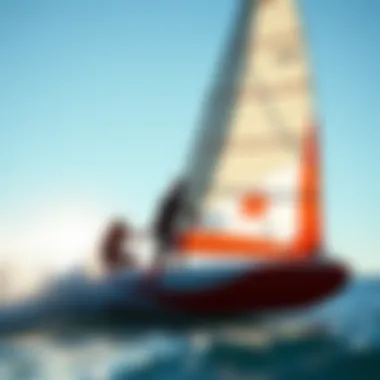
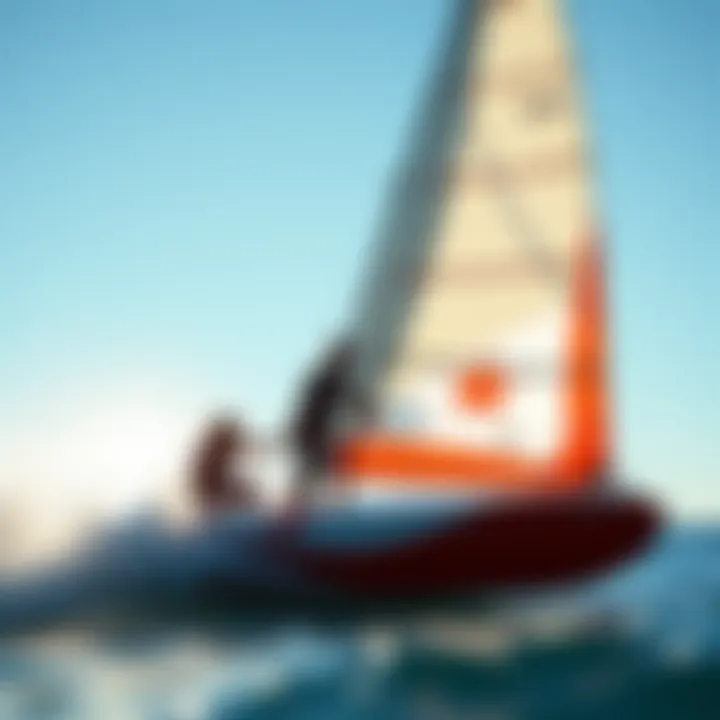
Taking care of the board involves various practices, such as regular cleaning and checking for dings or dents that might affect buoyancy and drag. A notable characteristic of board care is applying a protective coating every few months, as this can help in preserving the outer layer from scratches and sun damage. Considering the board takes the brunt of the impacts with waves and the surface, a well-maintained board results in better speed and comfort. However, overlooking these aspects might lead to needing more extensive repairs later, which could disrupt one’s sailing experience.
Inspecting masts and booms
Masts and booms hold everything together hence, inspecting them is pivotal. Regularly checking for cracks or wear and ensuring all fittings are secure is a key characteristic of mast and boom inspection. A small fracture can lead to significant danger while riding, making this aspect of maintenance highly beneficial. The unique feature of this segment is making sure components fit together snugly, avoiding excessive movement that could cause breaks. Conversely, not addressing the integrity could lead to a gear malfunction, jeopardizing not only performance but safety, too.
Storage Best Practices
Proper storage plays a crucial role in maintaining the quality of the sailboard equipment when not in use.
Weight distribution while storing
When storing equipment, focusing on weight distribution is essential. Placing the board horizontally on a rack with even weight on both ends prevents warping, which might otherwise occur with poor storage practices. This aspect of storage keeps everything in tip-top shape and allows for easy access whenever a sailboarder is ready to hit the water. Not maintaining balance can lead to distortions and a shortened lifespan of equipment.
Protecting against environmental damage
Environmental factors such as extreme temperatures and UV exposure can ravage sailboarding gear if not properly shielded. Using storage bags or covers to protect the gear can extend its lifespan significantly. A unique feature here is investing in a climate-controlled environment for long term storage—this keeps every part of the equipment safe from degradation. On the flip side, keeping gear exposed can lead to huge repair costs down the line, so it’s advisable to invest a little effort into safeguarding it when not in use.
Long-term storage considerations
For equipment that's going to sit unused for extended periods, proper long-term storage is paramount. This aspect involves taking extra steps like completely drying out sails and detaching sails from the boards to avoid compression marks. The ability to keep everything well-organized not only ensures longevity but also simplifies the process when it comes time to get back on the water. Failure to store equipment properly can leave athletes scrambling before a session, adding unnecessary stress to an otherwise engaging pursuit.
The Culture of Sailboarding
Sailboarding hasn’t just become a sport; it’s evolved into a vibrant culture that encapsulates both the thrill of waves and the camaraderie shared among enthusiasts. It’s not merely about riding the wind over the water but also about fostering a community bound by shared passions and values. The importance of understanding this culture lies in how it enriches the experience, making it about more than just equipment and techniques.
Groups of enthusiasts often gather, sharing tips, stories, and a love for adventure. This sense of belonging can significantly enhance one's enjoyment and commitment to the sport. Involvement in sailboarding culture can lead to friendships that last a lifetime, interesting travel opportunities, and a deeper appreciation for the environment and its preservation.
Communities and Events
Local clubs and associations
Local clubs and associations form the backbone of any thriving sailboarding community. They provide a platform for people to connect, learn, and participate in organized events. These clubs often host meetups that include workshops, group sail sessions, and social gatherings. The key characteristic of these clubs is their approachable nature; they usually welcome members of all skill levels, from seasoned riders to newbies with their heads in the clouds.
The unique feature of local sailboarding clubs is the shared resources they offer, like access to equipment or discounted prices for lessons. This collective pooling can make the sport more affordable for beginners, who might feel daunted by the individual costs of gear. On the flip side, sometimes the social dynamics can become cliquish, and it may take a bit for newcomers to find their footing within established groups.
Major competitions and festivals
Major competitions and festivals represent the peak of excitement in the sailboarding culture. These events showcase the prowess of top athletes and provide a spectacle for enthusiasts and aspirants alike. The atmosphere at these gatherings is electric, filled with the exhilaration of competition and shared experiences of tackling waves and winds.
The vibrant nature of competitions attracts attention, not only bolstering community spirit but also bringing valuable exposure to the sport. Watching skilled competitors push their limits can be an inspiring experience for newcomers. However, the pressures of competition can sometimes overshadow the essence of fun, creating an environment that may not appeal to everyone, especially those who prefer leisurely exploration.
Networking with other enthusiasts
Networking among enthusiasts presents an invaluable resource for individuals seeking knowledge and growth in their sailboarding journey. Social media platforms, local gatherings, and online forums offer avenues for sharing experiences, exchanging tips, and building friendships.
The beauty of connecting with fellow enthusiasts lies in the wealth of diverse experiences and insights they bring. Mixing with a variety of people can expose you to new techniques and regional specificities that elevate your understanding of the sport. Still, it’s crucial to approach these interactions with an open mind, as differing opinions can arise, leading to debates rather than learning.
Sustainability in Sailboarding
Responsible waterway practices
As awareness grows about environmental issues, responsible waterway practices have become crucial in the sailboarding community. Engaging in activities that protect marine ecosystems not only preserves the beauty of the landscapes we cherish but also promotes sustainability among enthusiasts. Methods like minimizing waste, respecting local wildlife, and following designated paths can significantly impact environmental health.
The dedication to preserving our waterways is a fundamental characteristic of modern sailboarding culture. The collective effort of participants creates a more enjoyable and sustainable environment for future generations. However, achieving total compliance can sometimes be a challenge as not all sailors adhere strictly to these practices, risking potential damage to fragile ecosystems.
Eco-friendly product choices
In the realm of equipment, eco-friendly product choices have gained attention, influencing both manufacturers and consumers. Products made from recycled or sustainable materials are now creating a niche in the market, reflecting a growing consciousness among buyers toward environmental responsibility.
Choosing eco-friendly products not only benefits the environment but can also improve performance, as many innovative materials possess unique properties. The downside, though, might be the higher costs associated with these items, which can deter some enthusiasts who stick to conventional options.
Community initiatives
Community initiatives serve as a powerful force in promoting sustainable practices and engaging new participants. Local groups often organize beach cleanups, educational workshops, and awareness campaigns aimed at encouraging responsible sailing habits. These initiatives foster a stronger connection between participants and their environments while cultivating a culture of respect and stewardship.
The strong characteristic of community initiatives is their ability to unite individuals under a common goal, creating a foundation of support. Participant engagement can lead to lasting changes, but without continued enthusiasm and interest, these initiatives may falter over time.
"Sailboarding is not just a sport; it’s a lifestyle that connects people to water and waves while fostering community and responsibility."
In summary, the culture surrounding sailboarding enriches the sport far beyond the physical act itself, highlighting the importance of community, events, and sustainable practices. These elements weave together to create a tapestry of shared experiences and environmental consciousness that define what it means to be part of the sailboarding world.
Ending
As we draw the curtain on this extensive discussion of sailboard equipment, it's crucial to emphasize the intricate tapestry that this sport weaves. Sailboarding is not just a surface-level activity; it’s a deep-rooted culture where equipment choices can profoundly influence one’s experience on the water. Navigating through this guide, we've unearthed significant insights and considerations that every novice and seasoned sailor should weigh carefully.
Recap of Key Insights
- Understanding Your Equipment: Knowing the different components, such as sails, boards, and masts, and how they interact can greatly enhance performance. Various sails, whether they are camber-inflated or free-hand, serve distinct purposes. For instance, larger sails typically catch more wind but can be cumbersome for those still finding their balance.
- Skill Level and Equipment Matching: The harmony between your skill level and your equipment is a dance, choreographed by experience and personal preference. Beginners might find large, stable boards more forgiving, while advanced sailors may seek out smaller, more agile options that allow for a full range of maneuvers.
- Environmental Factors Matter: Wind conditions, water temperature, and even local wildlife play a big role in shaping your sailing experience. Not to mention, safety considerations in weather variances should never be overlooked.
- Maintenance is Key: Regular checks and suitable storage conditions for your gear can extend the life of your equipment significantly. From gentle cleaning methods for your sail to the proper way to store your board, proper maintenance can save you from unnecessary replacements and keep your gear performing optimally.
Future of Sailboarding Technology
Looking ahead, sailboarding is poised for a wave of innovation. Integrating smart technology into equipment design is becoming a norm. Imagine how GPS devices will further enhance navigation during competitive events or leisurely rides. The incorporation of environmental sensors to assess wind patterns and water conditions is on the rise, offering customized experiences for sailboarders.
Moreover, there’s a growing trend towards sustainability in the materials used for equipment. Sailboards made from recycled products or more eco-friendly alternatives are appearing on the market. This not only benefits the sport but also aligns with a growing global movement aimed at responsible outdoor practices. As the community advocates for cleaner waterways, developers of sailboarding technology are also expected to keep pace with these practices.







